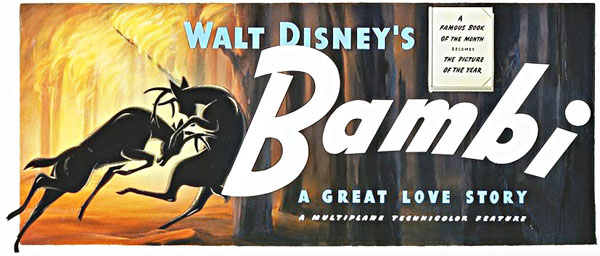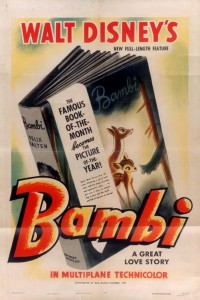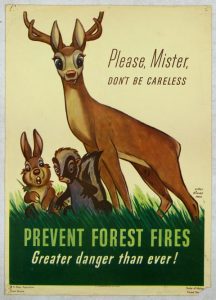
In June of 2003, the American Film Institute created a list of the top 100 Heroes and Villains in movie history. On the ranking of bad guys, nestled near Darth Vader, Norman Bates, and Hannibal Lecter was…Man… the villain from Disney’s 1942 animated feature, Bambi.
The film’s unseen villain came in at number twenty! There’s a good reason that this unique of all Disney and film villains ranked so high. “Man” in Bambi is responsible for one of the most shocking and gut-wrenching moments in film history and a scene in the film that ranks as a moviegoing rite of passage for generations.
Spoiler Alert (it may seem ridiculous to write that, but just in case) – It’s the sequence that results in Bambi’s father letting the young deer know, “Your mother can’t be with you anymore.”
As difficult as it is to believe, this year marks the 80th anniversary of Bambi, which was released to theaters on August 13th, 1942.
Jerry’s alternate blog, Animation Scoop, celebrated Bambi’s 75th just five years ago, here. To commemorate the 80th anniversary, what follows is a collection of quotes from some of the legends who brought us this Disney masterpiece and the many who have celebrated the legacy of Bambi:
“From the start, Bambi was a very different picture. It had fantasy and reality all its own, separate from Walt Disney’s other films. This was no imaginary forest that one could enter and leave at will. Whoever ventured in became part of an experience so strong that neither heart nor mind could ever forget its impact.”
– Animators Frank Thomas and Ollie Johnston, Walt Disney’s Bambi: The Story and the Film.
“This was the first time Walt saw what I could do as an artist. I did the young animals in the story, and apparently, he [Walt] was delighted with my drawings and said, ‘I want to see this guy’s drawings on the screen. Make an animator out of him.’ So, I was trained by a few of the other animators like Milt Kahl and Frank Thomas, and I stayed on Bambi for six years.
We moved out to the new studio, and we were up on the third floor, the 3D wing; and Walt had his apartment, and he would stay overnight. The man who was Story Director on Bambi was Perce Pierce; He had also been story director on Snow White. He would stand in the hallway when he knew Walt was coming, and he’d say, ‘Man is in the forest! Man is in the forest!’”
– Animator Marc Davis, 1998 interview with the author.
 “A sequence in Bambi had grown far too long. In desperation, Walt sat in the projection room with the directing animator to cut the sequence down. Walt would say, ‘You can cut here’ or ‘Cut this scene out entirely.’ The director complained, “I think I would lose something if we cut that out.’
“A sequence in Bambi had grown far too long. In desperation, Walt sat in the projection room with the directing animator to cut the sequence down. Walt would say, ‘You can cut here’ or ‘Cut this scene out entirely.’ The director complained, “I think I would lose something if we cut that out.’
Walt was exasperated. He stopped short and said, ‘Here I am, losing my shirt, and you’re telling me what you’d be losing.’”
– Director Ben Sharpsteen featured in Remembering Walt: Favorite Memories of Walt Disney by Amy Boothe Green and Howard E. Green.
“The situation: Bambi is learning to walk. He takes some steps and falls down. And Thumper says, ‘He doesn’t walk very good, does he?’ And his mother admonishes him [‘What did your father tell you?’] So in this scene, he says, ‘If you can’t say something nice, don’t say nothing at all.’
We try to squeeze every last drop out of each scene. The kid who supplied the voice was only four or five years old, and he had a little trouble remembering the lines… and it showed. So, we got the same hesitation into the animation. We even added time between ‘nice’ and ‘don’t.’ So he says, ‘nice,’ takes a breath and nothing comes out.”
– Animator Milt Kahl, 1960 Character Design and Development Lecture featured in Walt Disney’s Nine Old Men & The Art of Animation by John Canemaker.
 “… the ultimate childhood trauma of losing a parent is dramatized with honesty and power. It is these moments, not the occasional kitsch that audiences actually take away with them. On their indisputable strength rests the sound defense against the charge of schmaltz.”
“… the ultimate childhood trauma of losing a parent is dramatized with honesty and power. It is these moments, not the occasional kitsch that audiences actually take away with them. On their indisputable strength rests the sound defense against the charge of schmaltz.”
Writer James Morrow discusses Bambi’s mother’s death in his article “In Defense of Disney” in the April 1978 issue of Media and Methods.
“It remains one of the studio’s loveliest works, dealing in qualities of nature and life that will keep it young and fresh forever.”
– author and historian Leonard Maltin on Bambi in his book, The Disney Films.
“I heard they were doing Bambi, so, on my own free time, I did a lot of sketches of Bambi, with the forest background, and so forth, and took them into the studio. I think Phil Dike had something to do with that, and he looked at [Ty’s sketches] and he said, ‘What did you say you’re doing now?’ ‘I’m doing inbetweens.’ ‘I think you’re in the wrong department.’ They talked it over, and they said, maybe we ought to put this guy working on Bambi, it seems to be perfect for his style and so forth.”
– Artist Tyrus Wong, whose artwork became the inspiration for the distinct look of Bambi (from an interview with Michael Barrier, available at MichaelBarrier.com).


 Michael Lyons is a freelance writer, specializing in film, television, and pop culture. He is the author of the book, Drawn to Greatness: Disney’s Animation Renaissance, which chronicles the amazing growth at the Disney animation studio in the 1990s. In addition to Animation Scoop and Cartoon Research, he has contributed to Remind Magazine, Cinefantastique, Animation World Network and Disney Magazine. He also writes a blog, Screen Saver: A Retro Review of TV Shows and Movies of Yesteryear and his interviews with a number of animation legends have been featured in several volumes of the books, Walt’s People. You can visit Michael’s web site Words From Lyons at:
Michael Lyons is a freelance writer, specializing in film, television, and pop culture. He is the author of the book, Drawn to Greatness: Disney’s Animation Renaissance, which chronicles the amazing growth at the Disney animation studio in the 1990s. In addition to Animation Scoop and Cartoon Research, he has contributed to Remind Magazine, Cinefantastique, Animation World Network and Disney Magazine. He also writes a blog, Screen Saver: A Retro Review of TV Shows and Movies of Yesteryear and his interviews with a number of animation legends have been featured in several volumes of the books, Walt’s People. You can visit Michael’s web site Words From Lyons at: 






















“Bambi” was the first animated Disney feature I ever saw (second, if you count “Mary Poppins”). I remember crying my eyes out on the way home, not because it was so sad, but because it was so beautiful. The film made a very deep impression on me. I read the original novel and its sequel, Bambi’s Children, many times over; later they would be the first novels I read in German. I had a little set of toy plastic deer figures, which my sister and I would use to act out scenes from the books or make up our own adventures; we did that for years. Five years ago, after I delivered the eulogy at my father’s funeral, the first image that popped into my mind was of the final scene where Bambi and his father are looking out over the forest together, and then the stag walks away. It felt good to think of that, and it still does.
I don’t watch “Bambi” very often. It’s not a movie like “Dumbo” or “Jungle Book” that I can pop into the DVD player any old time. Circumstances need to be just right. I have to set aside some time when I know I won’t be disturbed, after dark, and I have to be in the right mood. No snacks, no bathroom breaks, no phone, and afterwards I need about half an hour to myself. To me, it’s a film that deserves not only attention and respect, but a measure of reverence.
“Bambi” is Disney’s most profound feature, because its subject matter is not just growing up, not just falling in love, but life itself, and all the wonder and tragedy it entails. Anyone with a beating heart will cry at “Bambi”, because it shows that in spite of all the heartache, life is beautiful, and love is a song that never ends.
I don’t know you personally, but you’re the kind of guy I would like to know better.
Likewise, Bob, and if you ever come to Australia we should hang out and watch cartoons. But everyone says I’m really boring in person!
I am not being sarcastic when I say the Animaniacs short “Bumbie’s Mom” deserves a place in history alongside this Disney masterpiece. Chuck Jones said “You must love what you parody,” and they definitely gave a loving homage to “Bambi” in this hilarious episode.
I remember that episode! The Bambi parody came out charmingly humorous because it was so relatable towards audience reactions.
In the 1970s at Toronto’s Rochdale College I showed the Disney animated features often. Rochdale was an experiment in alternate education as well as a residence. Each Rochdalian was called to be their own teacher. There were no teachers at Rochdale. What there was was what were called “Resource People.” These were people invited to live there at no expense on condition they made themselves available to talk with anyone who wanted to speak with them thanks to their expertise. One of Rochdale’s resource people was Judith Merril, the mother of modern SF of whom J. G. Ballard said, “She was the strongest woman in a genre created by weak and ineffectual men.” Whatever you feel about that statement Judy was strong. She was also the reason I became part of Rochdale. As part of the Rochdale experiment the government allowed the use of hashish, LSD, marijuana, mescaline and peyote. Experiencing the death of Bambi’s mother on LSD is nothing to take lightly. At one screening I had several members of a notorious motorcycle gang. They were crying like babies. Disney’s best films have a primal power. That is not to be messed with nor taken lightly. As for myself I prefer to experience these works without the assistance of other substances. I like to watch them work their own magic without the use of mushrooms.
Looks like none of my picks for movie villains made AFI’s list. Oh well, still a good list, and man from Bambi is an interesting choice for an entry.
I would’ve though Fantasia would’ve been a more natural to watch with LSD. Maybe it’s that that one already the hallucinatory elements there.
A long bit interesting read on the subject of Bambi:
https://sites.evergreen.edu/anthrozoology/wp-content/uploads/sites/142/2015/11/Lutts-Bambi-1992.pdf
But, I’m interested in this passage. Did that really happen? I thought it was discarded before the actual animation took place:
….one of many things to mention on Bambi….
….regarding “the scene” in which the viewer and Bambi learn of his mother’s death….
….is the ever-so-poignant and powerful, silence….
The chorus we have been hearing on the soundtrack as Bambi wanders through the forest, searching and calling “mother”, suddenly stops as Bambi gasps at the sight of his father just before he tells Bambi the fateful statement.
….one very good reason why I think this scene works so well: the impact of what can be heard, and then suddenly not heard, as well as what can be seen, the characters in the dark of night with the bright white snow falling in front of them….
Oh, my….the greatest of the great scenes of this film, perhaps the artistic pinnacle, especially visually, of the Disney Studio’s work. (No wonder Osamu Tezuka went to see it dozens of times; and it was inspiration for his “Jungle Emperor”.)
So wonderful also to celebrate this movie….(for, in addition to its statements and commentary on life and love,
it embodies a rarely discussed allegory of the Jewish experience, though not quite as extensive as that expressed in Mr. Salten’s original novel.)
I like to see works like this honored which have certain subjects at their core and “foregrounded” –
Since childhood, I’ve had a “thing” for deer; they are so beautiful and graceful!
Both the character design and, of course, the incredibly smooth and plausible movement, the animation, will forever make this film a true masterpiece, (no matter how technology evolves).
Thank you.